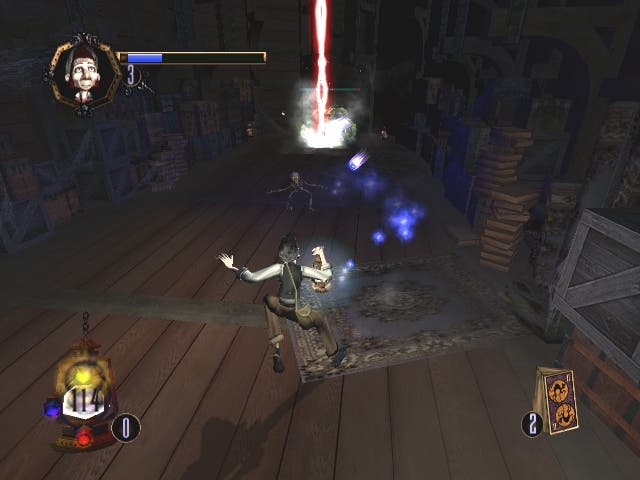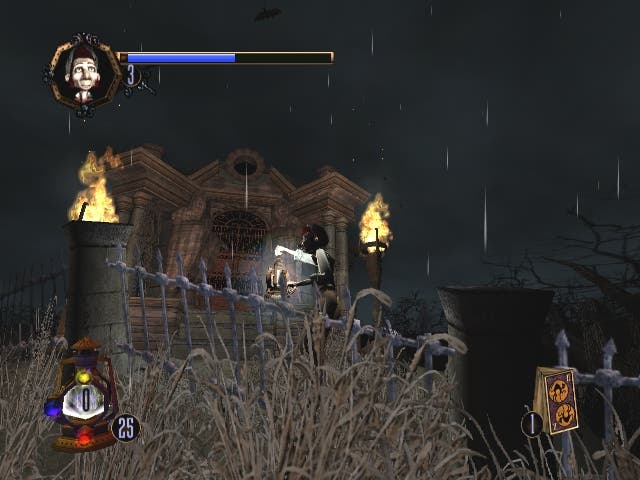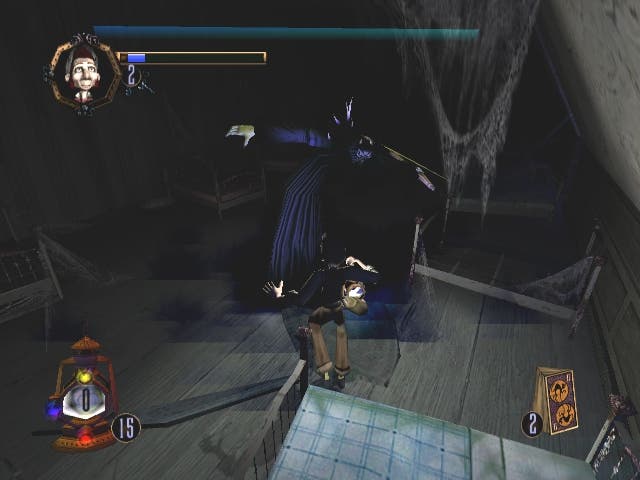The Haunted Mansion
Danger! High Voltage grabs Luigi's Mansion's Ghoulies.
Basing games on movies is one thing, but basing a game on the movie of a Disneyworld theme park ride is almost too much for my pea-sized brain to handle. Much easier to understand is that it's another haunted house game in the mould of Luigi's Mansion or Grabbed By The Ghoulies, with perhaps even a smidgen of Project Zero thrown in for good measure.
Zeke the beak

Haunted Mansion stars the big-beaked Zeke Halloway, who arrives at an old mansion after applying to be its assistant caretaker only to wind up gathering lost souls and fighting to let the ghostly residents live in peace. Essentially divided up into a series of challenge-based rooms, the game works on two basic levels. First you must solve the 'puzzle' of turning the lights back on in each room, and then you have to gather the Soul Gems contained within, repeating until the credits roll...
To begin with, High Voltage's third-person romp seems a little hollow, with pointlessly easy cannon fodder monsters to dispatch with a spurious zapping device. The energy system works on the basis of Zeke's 'bravery', and if our hero is touched by any of these spooks, he becomes increasingly scared until he eventually keels over. For reasons more to do with game design tradition than logic, Zeke comes stocked with lives and, of course, if you run out of these you die and it's game over. Slightly annoyingly, this arcane lives system dictates that you must regularly save your progress by wandering up to the nearest, um, grandfather clock, unless you enjoy replaying entire sections.
To begin with, you'll regularly pick up extra lives and be able to deal with pretty much anything the game throws at you. At this stage is feels like a comfortable kid-friendly kind of game, with little to frustrate or annoy you. The puzzles seem well structured, and at times absolutely ingenious, and progress seems to be geared towards a game that's designed to be steady, enjoyable and structured in short enough bursts to hold your interest throughout. A few rooms in, for example, Zeke gets miniaturised and forced to run the gauntlet from a ghostly billiards maverick, intent on potting the soul saver for good. If you line up Zeke well enough though, you soon realise that potting the balls is your lifeline and it has you nodding in appreciation at such an intelligent and original slice of game design.
Puzzling excellence

Such unique interludes are regularly repeated throughout The Haunted Mansion, and during these sections you'll delight in some of the best lateral thought puzzles ever devised. Oddness such as wandering behind walls and reappearing through paintings to turn them from bad to good is one standout head-scratcher, while dodging the gaze of rotating statues on a chess board is another. Only rarely did High Voltage fail to think of truly superb ways of shoehorning some lateral thought excellence into the "find the light switch" template, and if the team could focus a game on these elements, it would find plenty of admirers. Not since the glory days of graphic adventures have I seen such a pleasing array of brain teasers crammed into a videogame.
But then again, puzzle-based games just don't sound sexy to the industry these days, and rarely do you hear of one selling well. So what did High Voltage do to make it saleable? Shoved in relentlessly respawning drones that chase you around each room or connecting corridor and included a combat element to make it feel like a proper action game. This might have been acceptable - after all, Prince Of Persia pulled a similar stunt by chopping up the puzzle sections with sword fighting. You'd perhaps imagine that the puzzling/ghost-busting dynamic would work well. On paper it probably does, but in practice it's a tedious, time-wasting exercise that isn't enjoyable from the first room to the last.
To begin with, the various species of ghouls, spiders, knights, skeletons, grim reapers and so on are easily despatched with a frantic bash of R1. Later though they start blocking and descending upon you like the gates of hell have opened just above, and the weight of numbers begins to hang heavy as your lives begin to dwindle. After a few forgetful levels, you may find yourself having forgotten to save, and - heaven forbid - run out of lives. But with only one save slot to play with, you're forced to overwrite your last checkpoint, and - as I did - end up having to play some seriously hard sections with one life left.
Odd odds

As with most games, The Haunted Mansion thinks that the longer the game goes on, the harder the enemies should be. It does level up your shots to compensate, but when half the enemies have shields and appear in hordes, the odds quickly tip against you to the point where you'll wonder how on earth you're supposed to carry on.
With no block mechanism to call your own, and small scuttling cretins that give you literally no chance to avoid them, it's a fairly hapless task when the game decides to throw in an entirely arbitrary survival section that forces you to hold out against an unbelievable number of enemies for fully three minutes. The auto-target ought to help you out here, but rarely picks the creature you want to hit, while the more powerful ultra shots take too long to charge up and end up missing the mark most of the time. There's little you can do to avoid creatures that are faster than you and have swipe attacks that are impossible to avoid. Likewise it's hard to dodge the scuttling bugs and swooping ghouls that head for you in packs, at the same time as avoiding bigger, mostly armoured creatures that you're trying to take care of at a distance. In short, the combat starts off being pointlessly easy, then halfway through decides to be pointlessly hard.
Not only does this suddenly (and arbitrarily) force you to repeat tedious sections over and over again, but it could potentially kill your interest in what - up to that mid point - was shaping up to be a really enjoyable and quirky take on the growing mansion adventure sub-genre. To bail at this point would be to miss out on some really enjoyable (although fairly easy to conquer) sections, and arguably the best bits of the game. But even these are punctuated by regular assault interludes that just left me cursing "why!?!" They just added so little to the game, and I can only conclude that they were put in to make the game more appealing as a concept to the publisher. Surely no one can feasibly enjoy these trials?
Click on everything

Elsewhere, every time you've turned the lights on, the game forces the player to look out for trembling objects - often indiscernible in a big room - in order to retrieve the lost souls. But inevitably you end up just mechanically clicking on every item of scenery until they reluctantly pop out and flee away from the clutches of your manically stabbed circle button. Whatever, it's plainly not very much fun clearing up, however much of a klepto you may be, especially when doing so merely prompts more tedious ghoul spawnage.
It could have so nearly been an excellent, exciting, taxing game. It's even got one of the most polished, technically accomplished engines we've ever seen on a PS2 - and that's a lot of games over the years. The ostensibly Western art style may not to be everyone's taste, but I admired it in a TimeSplitters kind of way. The rooms are undeniably lavish, with excellent lighting effects giving High Voltage's art team opportunity to make the most of flickering flame effects and lengthening shadows. If there's one criticism, it's that it's all a bit too shiny and seemingly at odds with the intended musty, dusty setting. Nevertheless, it's still a great achievement to push so much detail around the PS2.
One area the team really didn't get right was the monsters, which at no stage seem to convey anything other than poor artistry, being neither scary nor well-animated or conceived in the right, er, spirit. And their lack of aesthetic appeal is hardly aided by their frankly rubbish drone AI behaviour. Remember Death in Gauntlet? Now imagine a game populated by them and you'll possibly begin to relate to why I just didn't get on with the combat or the enemies in general.
Creaky
Like I said, there was rich promise here, but High Voltage has dropped the ball with its sloppy approach to the combat. Clocking in at less than 10 hours on the first run through it's not a game that will outstay its welcome, and could make a decent value rental - for optimal enjoyment we suggest you stick on the infinite energy cheat halfway through, admire the puzzles and wonder what might have been...

